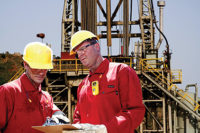Because of the number of new flame-resistant (FR) fabrics being introduced into the market today, selecting garments for your FR program can be a daunting task. Given so many options for fabrics, manufacturers and suppliers, where do you begin when trying to determine which products are best suited to the needs of your workplace?
In order to choose wisely, it is important to follow an outline of evaluation criteria to help you make the best selections for protection, comfort and value.
Begin with basics
Because FR garments are an expensive investment, you want to be sure your company gets the most for its money while providing the maximum protection and safety for your employees. Some of the key concepts to consider are:
1. What level of protection does the fabric provide, and will it deliver that same protection over time and after many launderings?
2. Will the next garment you buy from that supplier possess all the same qualities as the last garment you bought? Will the garments remain consistent in both quality and FR performance?
3. Can you be confident that a flame-resistant garment will provide your employee with the same level of protection over years in the field?
4. Will the FR garments you purchase over time from a particular supplier consistently pass all the same tests, since the fabric may have only been tested in the initial production lots (depending on the specifications of the given standard)?
5. Do you have confidence in the suppliers, both at the fabric and garment manufacturing level based on answers to the following questions:
a. Do they have experience?
b. Can they track every garment back to the
original roll of fabric from which it was made?
c. Do they fully disclose where their fabric is made and who made it?
d. Do both the garment and fabric suppliers follow an ongoing testing protocol?
e. Do they deliver the same quality each time?
f. Are the garments and/or fabrics certified?
g. Do they use all FR fabrics and findings in the manufacture of the garment?
h. Are they financially stable - will they be there tomorrow if you have any issues?
Think long-term
It is important to consider that garments and fabrics that meet the minimum requirements of a given standard may not be adequate to ensure the protection of your employees over the life of that garment. Although most legitimate FR products being sold in the U.S. today meet the standards for which they were designed, the testing is typically done from one lot of production, at one point in time in a laboratory and after only 25 launderings. Some garments today can last well beyond that, maybe as high as 100 launderings or more.
Flame-resistant workwear is secondary protection, designed to protect employees in the event of accidental exposure. This could happen after 10 washings of that garment, 70 washings of that garment or never during the life of that garment. But the key is to be certain that if the exposure happens, the garment will perform. This requires careful consideration of what fabric the garment is made from, which manufacturer made it, and the testing, protocols, integrity and expertise these suppliers possess when it comes to creating FR clothing.
Do standards address real-world conditions?
Another consideration is the difference between meeting the standards and real-world conditions. You should evaluate garments for durability, which includes reinforcements in stress areas, the way in which the seams are sewn together and the number of stitches per inch.
The garment should also be made from fabric designed to withstand harsher conditions than the minimum requirements on which some standards are based. Consider whether garments will be homelaundered or industrially washed. Depending on the fabric, elements like water PH, drying time, temperature and detergent could potentially affect long-term performance.
Are the garments comfortable?
After protection, comfort is the most important variable to consider, and comfort can’t easily be predicted in a laboratory environment. While test data like wicking, air permeability and fabric texture can be indicators of comfort, the best way to determine what will work in your conditions is to conduct wear tests with your employees. Wear tests are important because comfort can be perceived differently in different locations. For example, Arizona has dry heat and Louisiana has high humidity. Some fabrics may be perceived better suited to one environment than the other.
Another key factor in comfort relates to how the garments are sized and cut. Some companies cut smaller while others have a more generous fit. Features like extra gussets or a pleat in the back result in better ease of movement. And for non-standard employees, a manufacturer’s approach to creating non-stock sizes can make a real difference. Do they create a “short” size by just cutting off the legs of a “regular” garment, or do they actually adjust the pattern for the arms and torso to proportionally fit a shorter stature?
Are you getting the best value?
Once you’ve decided on the fabric that best meets the hazards your employees face, you might ask yourself whether it matters who actually makes the garment, as long as it is from your specified fabric. But some manufacturers really do create more durable products using construction techniques like reinforced snaps, lots of bar tack reinforcement stitches and double rows of stitching on the pockets.
While high-quality garments like this may cost a little more, their durability can make them a better value. After all, if you have to replace garments early because of shrinkage or loss of fabric strength, the cost per wear on that less expensive garment might be twice that of a higher quality garment that is stronger and has excellent shrinkage control. And if a garment doesn’t protect after being handled in conditions harsher than those on which the standards are based, it defeats the purpose of providing protection to begin with.
Budget pressures are relatively common these days, and purchasing departments might be tempted to only look at the initial cost, but there is more to it than that, especially for protective clothing. To make the best choices for both safety and economy, check the details in order to purchase the most protection, comfort and value for your money.

